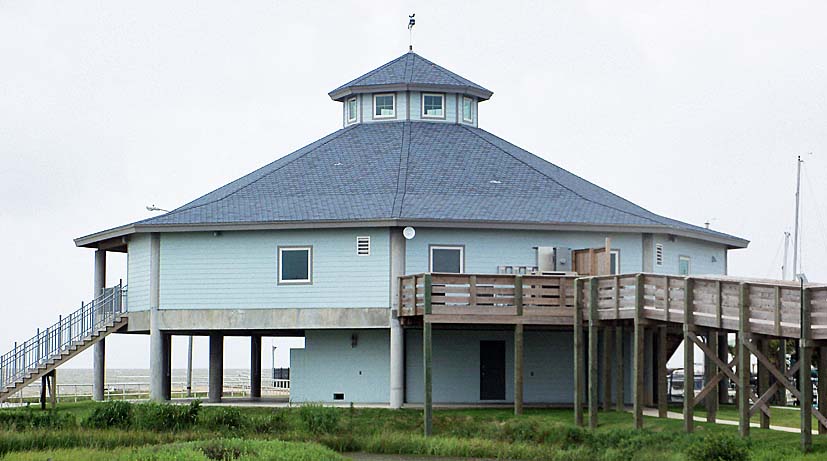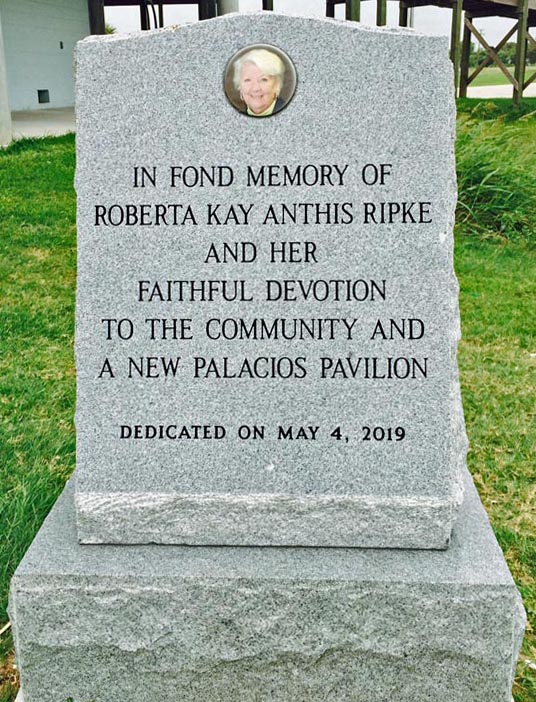|
PALACIOS PAVILIONS
By Mary Griffith
Marker photo courtesy of Katie Hutto
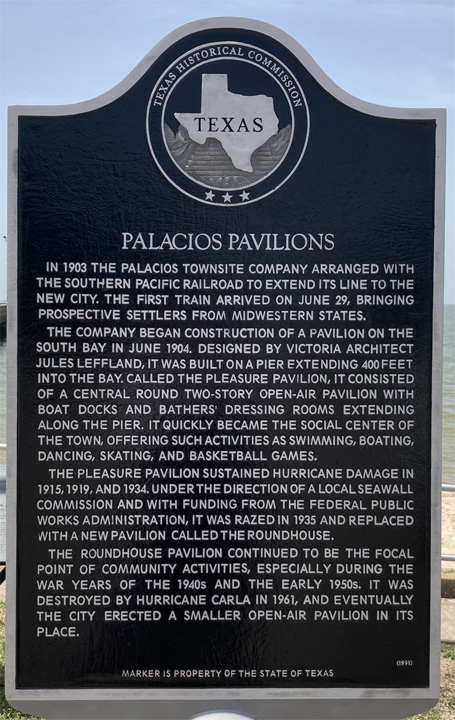 The town of Palacios, Texas, is located in the
southwestern portion of Matagorda County on Tres Palacios Bay,
(sometimes spelled Trespalacios) an inlet of Matagorda Bay off the Gulf
of Mexico. It is on the Coastal Plain of Texas on the “Hug-the-Coast:”
Highway Texas 35, halfway between Houston, Texas, and Corpus Christi,
Texas. The town of Palacios, Texas, is located in the
southwestern portion of Matagorda County on Tres Palacios Bay,
(sometimes spelled Trespalacios) an inlet of Matagorda Bay off the Gulf
of Mexico. It is on the Coastal Plain of Texas on the “Hug-the-Coast:”
Highway Texas 35, halfway between Houston, Texas, and Corpus Christi,
Texas.
The name Palacios comes from the bay on which it is situated, Tres
Palacios Bay, Spanish for “Three Palaces”. It has always been pronounced
to rhyme with “splashes”, although the Spanish pronunciation should be
“pah lah see ose”.
There is a legend that a Spanish ship sailing into the Gulf of Mexico
was carried into Matagorda Bay and wrecked. The sailors thought they saw
palaces on the shoreline in the distance and so swam toward the shore.
As they neared the shore, the “palaces” disappeared. They named the bay
“Tres Palacios”. In any case, this legend has been told from generation
to generation, even though research has revealed that the bay and nearby
creek may have been named Trespalacios for Jose Felix Trespalacios,
Spanish governor of Texas during the years of 1822 and 1823.
In 1901 a large tract of land known as “The Bull Pasture”, north and
west of Tres Palacios Bay, was offered for sale by the estate of A. H.
“Shanghai” Pierce. W. C. Moore, a Houston, Texas, business man, obtained
an option on the land. He, with a group of men from Louisiana, formed
the Texas Rice Development Company (TROC), purchased the land and
subdivided it into 160 acre tracts.
The mile-square tract on Tres Palacios Bay at Hamilton Point under the
name “Trespalacios”, was sold by a subsidiary of the Texas Rice
Development Company, The Palacios Township Company.
The townsite was surveyed into lots in September and October of 1902 by
J. F. Hervey, out of the Lewis Goodwin Grant No. 10 and T. D. Dasher
Grant No. 11, and filed for record in September, 1904.
The town, “Trespalacios”, was surveyed in 1902. There was a post office
a few miles up the Trespalacios Creek named Trespalacios, which made it
necessary to change the name of the town, so the “Tres” was dropped and
the town became known as “Palacios”. The area around the one-mile square
tract of Palacios was divided into five-acre tracts to be sold to people
moving into the area from the northern states and other parts of Texas.
Perhaps the one thing that decided whether or not Palacios would ever
develop as a town was the railroad. The Palacios Townsite Company paid a
bonus to the Southern Pacific Railroad to extend its line to Palacios.
The first train arrived June 29, 1903. Trains enabled excursions to
bring would-be settlers from the midwestern states and some of the
visitors stayed to become homeowners of Palacios.
One of the first buildings to be constructed was the Bay View Hotel
which faced East Bay. Building materials were brought from Louisiana and
consisted of long-leaf yellow pine for the frame and cypress for the
siding. Eighteen-inch cypress shingles were used for the roof. Mr. D. D.
Rittenhouse of Victoria, Texas, was the contractor-builder. The new Bay
View Hotel allowed the settlers and the promoters to move out of the
tents which had been their homes.
In the original plans for the City of Palacios, a strip of land along
the coastline was set aside for a “reserve”, which assured that the
coastline would have no private piers to detract from the beauty of the
coastline on South Bay and part of the East Bay.
The Palacios Townsite Company began erecting a pavilion on South Bay
midway of the reserve. It was located at the end of the street now
called Fourth Street, but at that time it became known as “Pavilion
Street.”
The new “Pleasure Pavilion” was begun on June 22, 1904, with Mr.
Jules
Leffland of Victoria, Texas, as architect and constructed under the
supervision of contractors, Hatchet and White of Bay City, Texas, on a
pier extending from a high bluff on shore to 400 feet into the bay. Its
style of construction was Victorian.
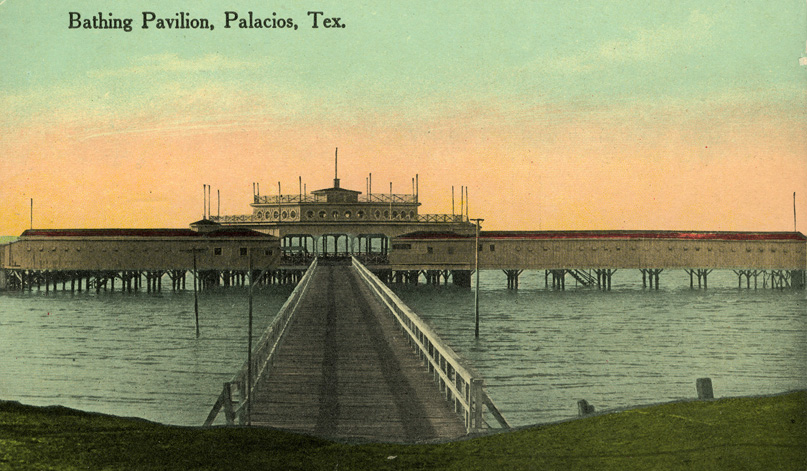
The open-air pavilion had a double deck, and a roof covered the entire
building. The lower deck was open to the cool bay breeze and was used
for dancing, skating, and for playing basketball games. A walkway, where
the public could sit on benches and look out over the bay or watch
swimmers in the water, circled the dance floor. This walkway was about
twenty feet wide with a balustrade to keep persons from falling into the
bay. Mothers would visit and watch their youngsters in the water.
Early photographs of the “Pleasure Pavilion” shows
flags flying, banners or bunting draped, bands marching on the pier,
women in long white dresses and huge white hats, and gentlemen in dark
suits and bowler-type hats.
Dressing rooms were erected east and west from the pier, and a catwalk
was on each end of the dressing rooms. Swimmers wore wool suits which
could be rented from the management of the pavilion. Women’s suits had a
ruffled skirt and a mob cap and most women wore shoes.
On the east side of the pavilion both high and low diving boards were
constructed. Early pictures show a slide built into the water which was
very popular.
A low pier was constructed on the east side of the pavilion for the use
of boats to dock. Sailing was popular at that time, to provide pleasure
and transportation. Coast-wise vessels were able to dock at Palacios
Point, a few miles south of Palacios, where smaller sailing vessels
docking at the pavilion, met passengers and brought them to the town of
Palacios. After the completion of the Intercoastal Waterway to Matagorda
Bay, the Palacios Townsite Company advertised the availability of
docking at the Palacios Pavilion. A few years later, the bathing
facilities on the west side were made into a restaurant.
On September 3, 1904, the Daily Tribune, Bay City, Texas, featured an
advertisement stating that the Palacios Townsite Company had arranged
with the Southern Pacific Railroad for special excursion rates on
Saturday and Sunday to visit the new pavilion, “The Finest on the Texas
Coast”, which would be opened on August 3.
The Pleasure Pavilion quickly became the center of community social
life, and it has continued through the years to be a meeting place, a
community center, to meet friends, to visit, or just keep cool in the
summer and sip soft drinks.
With the completion of the pavilion, the town’s tourist trade began to
prosper. In 1905 the Bay View Hotel was moved from the East Bay site to
a new location facing South Bay. The building was sectioned into three
parts and pulled over log rollers by many mule teams to its new site on
the edge of the “reserve” near the new Pleasure Pavilion. Additional
wings and its famous front porch, said to be the longest front porch
(400 feet) in Texas, were added to the structure. The hotel became known
as the Palacios Hotel and was the pride of the town.
During this time the hotel retained a permanent orchestra, which
provided music during lunch and dinner hours. Concerts were given on the
Pleasure Pavilion. Since the early days, the hotel has provided a
pleasant home base for hunters and fishermen. The hotel, now known as
the Luther Hotel, was renowned for its excellent food and could
accommodate 200 diners and dancers at the time. The hotel became a
recorded Texas Historic Landmark in 1965.
In 1906 thirteen acres of land on Hamilton Point, just three blocks from
the pavilion pier, were deeded to the Baptist Young Peoples Union of the
Texas Baptist Convention for a permanent encampment. These were the only
camp facilities in the state and were supported by Baptist churches
throughout Texas. In 1917 the enrollment was recorded at 3,000 persons
with 17 states represented.
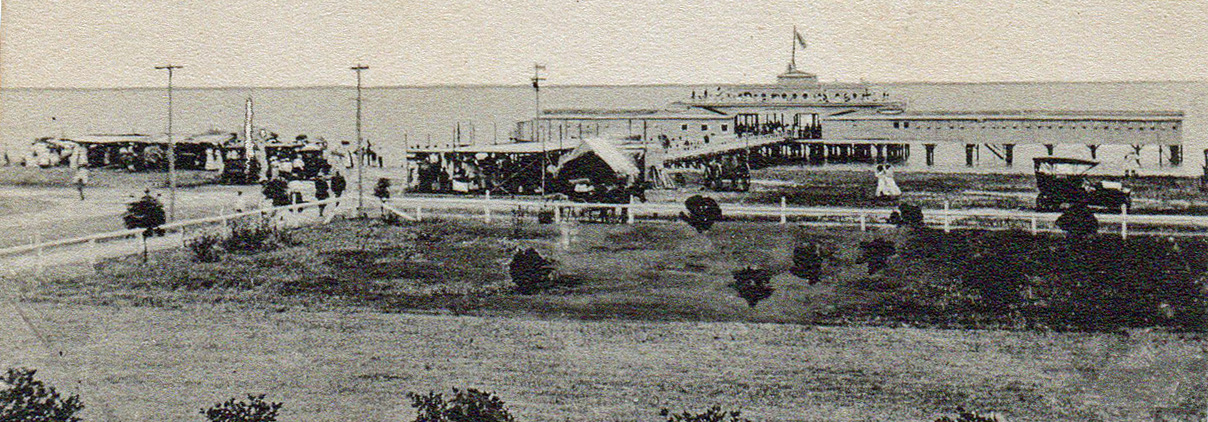
The coastline of Texas has been threatened by several Gulf storms. In
1915 a hurricane removed the back pier and back landing from the
pavilion, but it was replaced almost immediately. Schooners and other
boats carrying passengers and goods docked and sailed from the pavilion.
Summer visitors at the Baptist Encampment or in town would go sailing to
the Gulf or Hurd’s Landing up the Tres Palacios River.
In 1919 another hurricane removed the floors of the pavilion and some of
the pier leading to the shore. The pavilion and pier were soon
renovated.
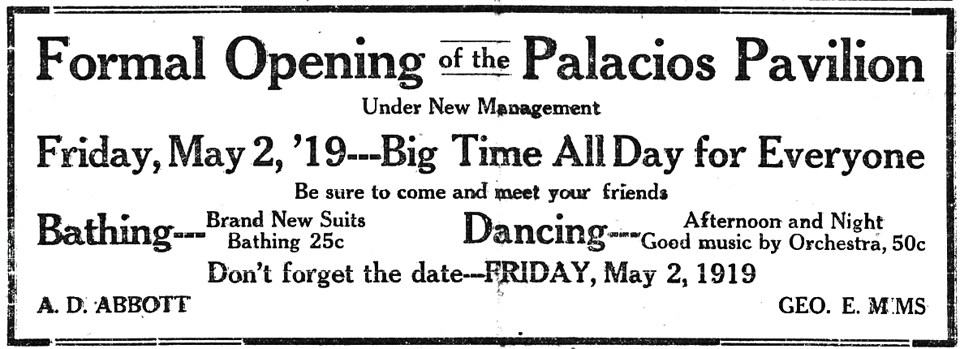
Palacios Beacon, April 25, 1919
During the 1920s, the pavilion managers usually hired an orchestra for
the summer. The orchestra played at the Palacios Hotel during the day
and at the pavilion at night. Many persons who were interviewed stated
that one of their fondest childhood memories was lying on benches or
pallets (quilts) listening to the orchestra and the sound of waves below
the Pleasure Pavilion.
In 1932 local business men purchased the pavilion from Mayhew Lumber
Company, the mortgage holder. The bathing booths on the west side were
removed to make room for a restaurant and soda fountain.
In 1934 a hurricane destroyed the back pier, diving chute and several
feet of the pier near the shore. The Pleasure Pavilion was more than 30
years old and needed renovating.
The Women’s Chamber of Commerce and the club women of the city urged the
building of a community center on the city Park. Ordinances of the city
and the railroad prevented it. The cost of the two structures was so
high that they had to be satisfied with one building.
A Seawall Commission was formed, consisting of Carlton Crawford, Dr. J.
R. Wagner, and George L. Harrison, County Commissioner, to supervise the
building of both seawall and a new pavilion.
The Palacios Bay Development Co. was low bidder on razing and removing
the old Pleasure Pavilion and pier.
The Seawall Commission and their architect, Homer Trimble, drew up plans
for the seawall and the new pavilion. It became known as “The
Roundhouse”.
Construction of the new pavilion was financed by remission of Texas
State Advalorum Taxes by a Special Session of the Texas State
Legislature, plus $30,000 bonus from the Federal Government. Labor was
furnished by local workmen as approved by the Public Works
Administration, Docket No. 4835 of Fort Worth, Texas, and Washington,
D.C. The loan and grant which amounted to $148,000 enabled construction
to begin on the new pavilion, “The Roundhouse”, as well as the seawall.
As soon as the Pleasure Pavilion wad demolished in May, 1935, and the
seawall construction on the shoreline had been partially completed,
construction on the Roundhouse began. Over a thousand feet of seawall
was constructed at that time.
The Austin Bridge Company under contractor J. G. Nash began construction
of the pier, which was 24 feet by 600 feet and terminated in a 75-foot
T-head. It had a catwalk on each side for fishing and mooring boats. The
pier leading to the pavilion and the T-head were finished with
reinforced concrete. Automobiles could be driven on the pier and the
T-head was used for parking or turning around. There were ornamental
railings and lamp posts at intervals along the pier and T-head.
The pavilion was 360 feet out in the South Bay from the seawall. The
floor of the pavilion was about two feet above the pier, and it was on a
level with the street. The main pavilion was built on 132 pieces of
heavy creosoted pilings 26 feet long. The main floor was 100 feet in
diameter with a seating capacity for 600 persons. The bleachers were on
the east and west sides which left an area of 60 by 80 feet for
basketball, dancing, banquets, and public meetings. The main pavilion
was built in a huge dome supported by steel girders with no center
supports. The bath houses were built on the south side of the pavilion
with showers and toilet facilities.
The walls of the pavilion had 120 casement windows and folding doors.
The orchestra and speaker’s platform were on coasters so as to be moved
to various positions. Basketball goals were also built on coasters. The
pavilion was equipped with loud speakers and floodlights.
To the south was a two-story building which was connected to the
pavilion by a hallway and stairs; lockers and restrooms were on the
first floor. On the upper floor was a seafood café called the “Pier
Cafe”.
The Roundhouse was open every afternoon and night. Private parties came
to play the nickelodeon and dance, and fisherman stopped for
refreshment. When the pavilion was not open, it was closed by an
ornamental-iron gate.
The pavilion was used as a community hall, for Y.W.C.A. business
sessions, P.T.A. meetings, recreational evenings, picnic lunches, and
political and social banquets.
The Gardner Brothers, Steve and Fred of Austin, Texas, with a large
combined orchestra, leased the Roundhouse for five years. They were well
known and it was said that people all over South Texas came to hear the
Gardner Orchestra.
In October 1935, the Palacios Seawall, South Bay Pier, Roundhouse, and
accessories were deeded to the City of Palacios.
The pier was open to the public at all times. The Roundhouse itself was
not open as a “loafing” place, but it was always open for public
meetings of every nature. Birthday parties, basketball games and
tournaments were held there, also.
On Saturday night, October 12, the Palacios Chamber of Commerce and the
Seawall Commission held a gala opening of the pavilion with a dance
following a reception at the Hotel Palacios. Over 1,500 persons attended
the dedication of the pavilion and pier on November 7, 1935, as reported
by the Palacios Beacon.
In 1925, a group of citizens formed the Palacios Campsite Association to
serve as the Training Camp of the Thirty-sixth Division of the National
Guard. It was named Camp Palacios. In September 1930, Camp Palacios was
renamed Camp Hulen in honor of General John A. Hulen.
Camp Hulen was leased by the Federal Government in 1940 for Coast
Artillery, Anti-Aircraft Training. Many soldiers arriving to Camp Hulen
sought living quarters for families in Palacios and nearby towns. The
population of Palacios swelled by the hundreds after World War II was
declared. The U. S. O. built a structure in the next block east of the
pavilion which led to the popularity of the Roundhouse.
The 1940s found the pavilion in its “hey-day”. The Roundhouse continued
to attract people from the surrounding areas. Many popular bands such as
Tie Tieman, Tex Beneke, Harry James, Bob Crosby, and Artie Shaw played
there during the 1940s and the 1950s.
On September 11, 1961, Hurricane Carla destroyed the Roundhouse
Pavilion. It left the great dome looking like a punctured umbrella and
the concrete pier in chunks. A Palacios Landmark was gone. Though there
were many “ups and downs” throughout its history, the Roundhouse and the
Pleasure Pavilions were always a source of pride to the citizens of
Palacios and surrounding areas.
A former resident of Palacios wrote about the Roundhouse: “It is really
hard to write so factually while being inundated with great waves of
nostalgia. What fun I had as a child swimming there with Mother watching
from the pier to make sure we didn’t drown! I took a Red Cross
Life-saving Course off the catwalks and in later years probably danced
100,000 miles there. It was so hard to realize that it was gone after
1961 and I guess there are lots of us who might get a little teary
remembering the fun and days of our youth with the Pavilion as a
backdrop.”
Eventually the floor of the old Roundhouse Pavilion was replaced on the
round area, and the pier received new wooden planking. Open-air dances
were resumed, but the pier was not open to public automobile traffic.
The “Open-air Pavilion” rises at its center nearly 27 feet above the
dance floor with a line of rafters and beginning approximately 12˝ feet
above the floor. The covering looks circular although in actuality it is
a 20-sided figure with each side being 17 feet long. The roof is
designed to relieve wind-induced stress on the structure. The plywood
sheathing may be blown away, but the basic frame should remain intact.
The center pole rests on a massive wooden cradle built beneath the deck,
but it is above the high-water mark. All perimeter upright supports are
tied to existing pilings of the Roundhouse.
The pavilion roof was part of the $217,000 South Bay Park improvement
project approved in 1983 by the Texas Parks and Wildlife Department’s
Park Division for a 50-50 matching improvement project.
The Seawall Commission was re-activated for the purpose of raising the
existing seawall of 1935. A splash walk with railings around the seawall
is enjoyed by many citizens who take exercise in the bay breezes or fish
over the railings.
The Palacios Pavilions have always been an attraction to our “Winter
Visitors” and surrounding communities as well as to those who have grown
up in Palacios.
The dedication of the Texas Historical Marker for the Palacios Pavilions
was held September 7, 1991, at the Pavilion Park on South Bay Boulevard,
Palacios, Texas.
PALACIOS PAVILIONS
IN 1903 THE PALACIOS TOWNSITE COMPANY
ARRANGED WITH THE SOUTHERN PACIFIC RAILROAD TO EXTEND ITS LINE TO THE
NEW CITY. THE FIRST TRAIN ARRIVED ON JUNE 29, BRINGING PROSPECTIVE
SETTLERS FROM MIDWESTERN STATES. THE COMPANY BEGAN CONSTRUCTION OF A
PAVILION ON THE SOUTH BAY IN JUNE 1904. DESIGNED BY VICTORIA ARCHITECT
JULES LEFFLAND, IT WAS BUILT ON A PIER EXTENDING 400 FEET INTO THE BAY.
CALLED THE PLEASURE PAVILION, IT CONSISTED OF A CENTRAL ROUND TWO-STORY
OPEN-AIR PAVILION WITH BOAT DOCKS AND BATHERS’ DRESSING ROOMS EXTENDING
ALONG THE PIER. IT QUICKLY BECAME THE SOCIAL CENTER OF THE TOWN,
OFFERING SUCH ACTIVITIES AS SWIMMING, BOATING, DANCING, SKATING, AND
BASKETBALL GAMES.
THE PLEASURE PAVILION SUSTAINED HURRICANE
DAMAGE IN 1915, 1919, AND 1934. UNDER THE DIRECTION OF A LOCAL SEAWALL
COMMISSION AND WITH FUNDING FROM THE FEDERAL PUBLIC WORKS
ADMINISTRATION, IT WAS RAZED IN 1935 AND REPLACED WITH A NEW PAVILION,
CALLED THE ROUNDHOUSE. THE ROUNDHOUSE PAVILION CONTINUED TO BE THE FOCAL
POINT OF COMMUNITY ACTIVITIES, ESPECIALLY DURING THE WAR YEARS OF THE
1940s AND THE EARLY 1950s. IT WAS DESTORYED BY HURRICANE CARLA IN 1961,
AND EVENTUALLY THE CITY ERECTED A SMALLER OPEN-AIR PAVILION IT ITS
PLACE. (1991)
|
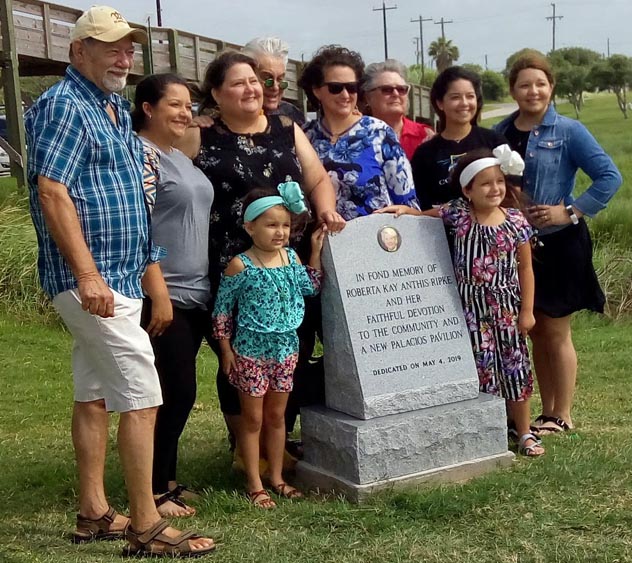
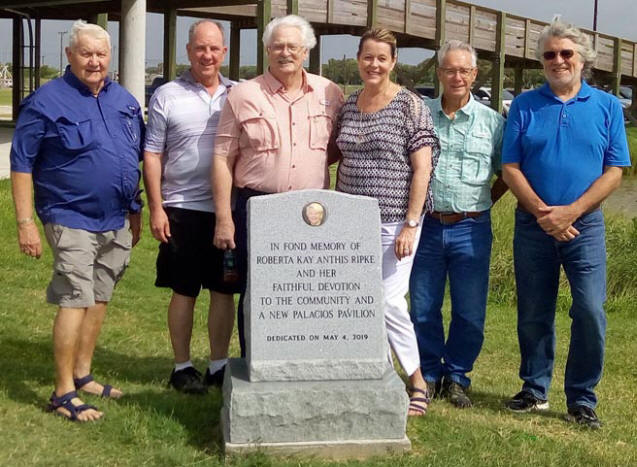
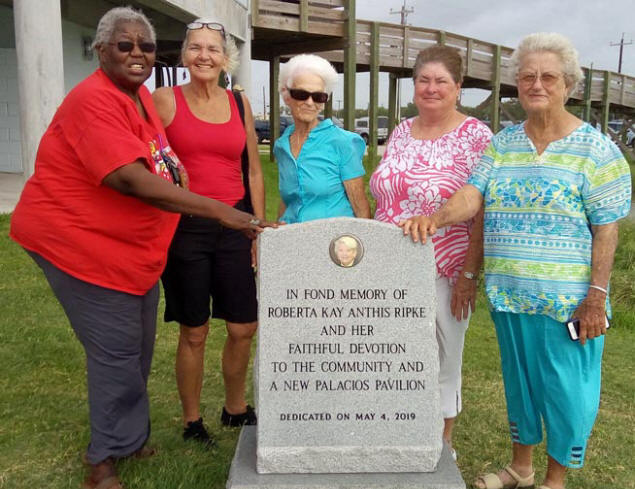
 The town of Palacios, Texas, is located in the
southwestern portion of Matagorda County on Tres Palacios Bay,
(sometimes spelled Trespalacios) an inlet of Matagorda Bay off the Gulf
of Mexico. It is on the Coastal Plain of Texas on the “Hug-the-Coast:”
Highway Texas 35, halfway between Houston, Texas, and Corpus Christi,
Texas.
The town of Palacios, Texas, is located in the
southwestern portion of Matagorda County on Tres Palacios Bay,
(sometimes spelled Trespalacios) an inlet of Matagorda Bay off the Gulf
of Mexico. It is on the Coastal Plain of Texas on the “Hug-the-Coast:”
Highway Texas 35, halfway between Houston, Texas, and Corpus Christi,
Texas.


